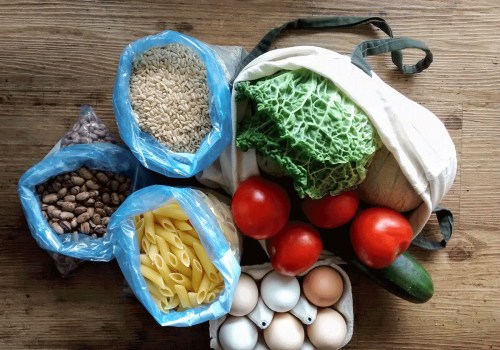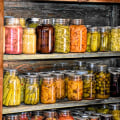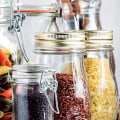The best way to extend shelf life Cool place: keep food in a cool place, some prefer sub-zero temperatures. Dry place: little or no humidity in the air for wheat, flour and other items. This is true for 99% of dry products. If you don't have space to store containers above broth containers, pick up a broth container.
This broth starter can be dissolved in water to make your favorite soup or can be added to sauces for flavor. In all cases, the estimated shelf life is for food stored at room temperature or slightly cooler, not in the refrigerator or freezer, which will substantially extend the shelf life of most items. Evolving technology has brought many more options to grocery store freezers, and there are a number of foods that couldn't be bought frozen 35 years ago. As with potatoes, store them in a cool, dry and dark place for maximum longevity.
And, as stated above, don't store them with potatoes; both will spoil faster. Peanuts in shell, especially when kept fresh and dry, are perfectly happy in the pantry for up to two months. The various types of thick-skinned winter squash, such as nutmeg, spaghetti, acorn, kabocha and hubbard, among others, are among the most durable fresh vegetables. Apples kept in a fruit bowl at room temperature generally last five to seven days.
However, when stored in a humid place at a temperature of 30º to 40º F, they can remain crisp and fresh for up to six months. Dry tea leaves, whether loose (in a sealed container) or in tea bags (in an unopened box), can easily last a year or more if not subject to moisture or moisture. However, tea tends to lose flavor over time. The color, texture, or flavor of powdered milk may change as it ages, but it will remain perfectly usable and safe for at least 18 months.
Oxygen and moisture are the enemies of these useful little blocks of instant soup or broth. Keep them dry and well sealed, and probably 24 months is the least they'll last. Because milk chocolate contains dairy products, it spoils more quickly than chocolate with high cocoa content and little or no milk. Warm temperatures are dark chocolate's enemy, and while it should last a couple of years at temperatures up to around 75° F, it will last up to five years if the thermometer stays between 60° and 65° F.
Chocolate exposed to high temperatures may develop white spots, but they are harmless and do not affect taste. Although honey is often sold with an expiration date (usually between two and five years from the time it is packaged), this is because over time it can darken and form sugar crystals, something totally harmless, but unpleasant for some consumers. 100% pure, undiluted honey in an unopened jar (stored away from heat) will remain edible years, decades, probably generations later. A longer shelf life allows for greater seasonality, less food loss and a greater chance of maintaining freshness.
When it comes to preparing, there's nothing more important than having a good supply of the basics that keep us alive. The basic elements of preparation are, of course, food, water, safety and shelter. But the biggest struggle for many is finding foods that last a long time. In this post, we look at the 20 best foods to prepare for long-term storage and how to extend the shelf life of your food.
For me, I wouldn't want to live on beans for a whole year if I knew that there are other options that I could easily buy at my local supermarket that would last more than five or 10 years, and I know that you are the same. While these foods may seem simple and simple, it's great to add them with canned foods you might have canned yourself or with your emergency food. As with rice, if you package dry beans properly, they can last up to 30 years. To extend the shelf life of dry beans, they should be stored in airtight containers with moisture prevention to prevent deterioration of preserved foods.
One of the best bulk options we tried were Augason Farms pinto beans, which are contained in an airtight 6-gallon bucket that includes 432 servings. Sure, I mentioned earlier that dried beans every day can be a bit boring, but if you add them with rice and a few different spices, you can make a lot of interesting mixes to contrast with your food reserves and the types of recipes you can create with your doomsday reservation. To store dry beans, it is recommended to use food storage containers that are hermetically sealed and mylar bags that stop the absorption of oxygen for foods in the long term. The bags help considerably to extend the shelf life of almost all the food you want to store.
There are also several other ways you might want to consider to extend the shelf life of your food. Oats are incredible and a very satiating food source that can be easily used in all types of meals and snacks. Of course, they're not as easy to cook as most other types of food, but they can last more than 30 years if preserved the same way as beans. And did we mention how cheap they are?.
The health benefits of oat flakes, like the ones we tested at Honeyville, are rich in antioxidants, contain a powerful soluble fiber called betaglucan, and can lower cholesterol levels and protect LDL cholesterol from damage. Pasta is an excellent storage food, as it's another carbohydrate element that can be mixed with anything else to make a cold or hot pasta, depending on what you're looking for. For most commercially packaged freeze-dried pastes, they have a shelf life of between 8 and 30 years. There are several ways to store cheese, such as waxed cheese, canned Bega cheese, Kraft and freeze-dried cheese, and it can last a long time for a dairy product.
Rice can easily last up to 30 years, but once again, it must be stored in food-safe food storage containers and bags. Canned corn and dry corn are cheap, tasty and have an easy shelf life of 10 years. Their lifespan is generally 4 to 5 years, but if you add them to Mylar oxygen-absorbing bags, they can last up to 20 years. They are ideal to put in the bag or in any 72-hour survival kit, as they always come with a lot of different foods in a single package that you can mix or eat alone.
MREs are also great for use in short-term scenarios, such as disasters, where you need to rely on an emergency food source for a short period of time. This is why most 72-hour survival kits have an MRE or freeze-dried food to go. Food freezes quickly: Fresh food or freshly cooked food is placed in a special dryer where it is frozen at high temperatures (-40 degrees Fahrenheit or lower). This is a quick freezing method, so food freezes in an instant.
In our post on how to extend the shelf life of foods, we have 20 tips you might want to follow. Can you make rolled oats sprout? You can make oats germinate, but I thought the mechanical lamination process prevented growth. Various processing methods can improve the shelf life of a food product. The most common methods are pasteurization, sterilization and fermentation.
Scientific techniques, such as thermal processing or pasteurization, involve applying a gentle heat treatment below 100 degrees Celsius to food products, to reduce the microbes present in the product. In the food manufacturing industry, shelf life plays an important role in determining food quality. Freeze-dried food, which was initially created for astronauts to ensure they had durable food on their space missions, is now a staple item for the military, hikers, campers, survivors and preparers. Food companies generally add antioxidants and oxygen absorbers to reduce oxidation, improving product shelf life.
Many foods with an extended shelf life are the staples, such as rice, grains and salt, but others can last a long time because they are dry or canned. Manufacturing food in a temperature-controlled environment is the most commonly used technique to increase the shelf life of an edible product. Using oxygen absorbers (the amount depends on how much food you have in the bag) will prevent oxygen, moisture, and any potential bacteria and mold from growing in food. If at any stage of manufacturing the food product is faced with temperature abuse, the shelf life may be significantly reduced.
From a nutritional point of view, there is very little difference between foods that have not been freeze-dried and foods that have not been freeze-dried. No doubt, you'll find that most preparers use mylar bags in their food storage containers, which only reinforces the protection of your food. Another common food processing technique is blanching, in which food is pre-treated with mild heat with hot or boiling water. And not only do preparers ask about food that has a longer shelf life, but also settlers, emergency workers, the military and many other communities.
So let's take a look at what we can eat that has the longest shelf life and foods that last a long time. . .







